[bars]
Common Names: Alexandrine Parakeet, Alexandrine Parrot
Scientific Name: Psittacula eupatria
Origin: Southern India, Afghanistan, Pakistan, Nepal, Andaman Islands, Sri Lanka.
Relative Size: 23-25 inches
Weight: 230-250 grams
Average Lifespan: 20-30 years
Egg Clutch: 2-4 white eggs
Incubation: 26 days
Talking Ability: Excellent
GENERAL INFORMATION ABOUT ALEXANDRINE PARAKEETS
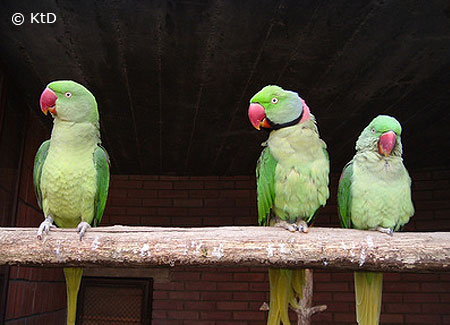
Alexandrine Parakeets are large compared to most Asiatic parrots and are similar in size to their Asiatic cousin the Derbyan Parakeet. These birds look very similar to Indian Ringnecks; however, there are differences to the trained eye.
These parrots are sexually dimorphic. This simply means males and females are easily differentiated. The male has a black ring, highlighted with blue and pink, while the female does not. The males will start to develop their ring around 18 months and will have the full ring visible by three years.
In the wild, these large ringnecks are seen showcasing a greenish gray body and forest green wings. These parrots are easily identified by their massive upper red beaks, maxilla, and maroon patches found on their wings. In comparison, the Indian Ringneck has a smaller beak and lacks the maroon colored patches seen on the Alexandrine parrot.
[ads]
Alexandrine Parakeets have long tails that can extend a foot or more from their bodies. In fact, their tails are so long that they usually are longer than the body itself. The two largest tail feathers are blue and have a slight yellowish white at the tip. When the parrot is in full flight, yellow can be seen under the tail and wing feathers.
Alexandrine Parakeets seem to be mainly sold for their vibrant colors and there are many mutations available. These derived mutations have been a source of controversy as they were achieved through hybrid breeding with the Indian Ringneck. Many bird enthusiasts worry the bloodline of a true Alexandrine Parakeet will be difficult to find, while others believe that the art of hybridization is totally ethical as humans have succeeded to practice this on dogs, cats, and horses for hundreds of years. Because of hybridization between the two species, there are now lutino, blues, cinnamons, lacewings, and pieds showcased in the market today.
It is important to note these mutations have taken 25 or more years to establish and many serious breeders have detailed records to ensure their mutations have very little Indian Ringneck blood. The breeding has been so successful that the hybrid parrot looks like a true Alexandrine. First generation hybrids often look like larger Indian Ringnecks with maroon patches on their wings.
ALEXANDRINE PARAKEETS IN THE WILD
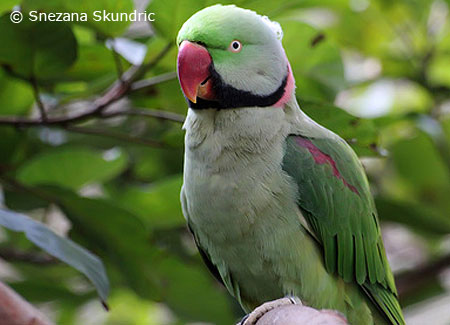
When seen in the wild these parrots form small flocks and can be seen on the ground foraging for food. In the wild they feed on a variety of foods and are omnivores by nature. All dine on blossoms, fruits, and seeds.
These ringneck parrots are most comfortable in the trees and are considered sentinel birds as they will emit loud calls when danger is seen. These birds are often difficult to see when perched in their environment and camouflage very well. Oftentimes, their calls can be heard, but is very difficult finding them in the trees once perched.
During the breeding season these birds will branch off into pairs to raise their offspring. The female will find a hollow nest cavity, usually inside a large tree, and incubate the eggs whereas the male watches for danger and feeds the female.
ALEXANDRINE PARROTS IN CAPTIVITY
Alexandrine parrots are still not that common in captivity compared to their other Asiatic cousins, the Indian Ringnecks. Bird enthusiasts can sometimes find these parrots at a bird show or through exclusive breeders. It is unfortunate because these parrots are easy to breed and make fantastic pets.
The ancient Romans were very fascinated by these parrots, especially Alexander the Great. He often exported these parrots back to the Mediterranean area and marveled at their mimicking ability. The ancient Asians also regarded these parrots as masters of mimicry and made them household pets. Unfortunately, habitat destruction has diminished their presence in the wild and many countries such as Pakistan and India have now outlawed trapping these parrots.
ALEXANDRINE PARROTS AS PETS
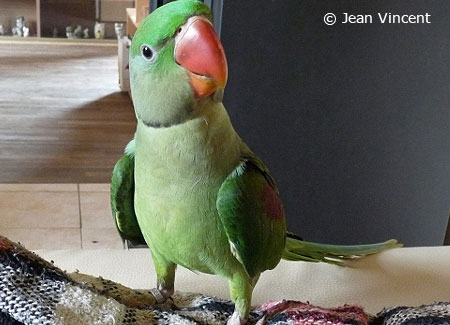
Quite simply, Alexandrine parrots make wonderful pets if they have been handfed. They have so many positive attributes such as their size, beauty, and intelligence. Though these graceful parrots look similar to their cousins the Indian Ringneck, they behave quite differently. These birds are usually very charming and subdued. They enjoy being stroked in the direction that their feathers grow and owners can easily enjoy spending time with them while watching television, reading the newspaper, or relaxing. In addition, they like being petted alongside the back of their neck where the ring is displayed.
These parrots are known for their talking ability as well as their talking clarity. Some Alexandrines can pick up extensive vocabularies and will not remain quiet once talking has been mastered. Most start talking around eight months, but the average Alexandrine starts to talk after a year. Both males and females are able to talk, although the males seem to pick up larger vocabularies and are much more gifted when it comes to clarity. Most Alexandrines have their own tone when speaking and will not adopt the tone of their owner’s voice like the African Grey.
It should be noted that buying an Alexandrine for its talking ability is not recommended as some will never learn to talk. The best talking Alexandrines are those who have been exposed to humans at a young age, have been properly socialized, and integrated into the owner’s household.
These parrots are very playful and need plenty of toys to be stimulated. Alexandrines are known for their constant chewing and destructive behavior if not supervised. Because their beaks are large, many will need sturdy wooden toys to sustain them for a few hours. Other items such as leather, ropes, and large plastic beads are highly enjoyed – especially if they are brightly colored. The toys should be added weekly and rotated to ensure the parrot does not suffer from boredom.
Though Alexandrine parrots are known for their independent nature, they still crave human attention. Many handfed Alexandrines find it difficult to be away from their owners and can quickly develop destructive behaviors such screaming, feather picking, or become easily depressed. This means it is crucial the owner teach the parrot at an early age to play independently when not being held.
A play stand for the parrot is important and essential as this gives the bird out-of-cage time and allows the bird to flap its wings without the restraint of a cage. The stand should have plenty of toys and should be easy to clean.
These majestic birds are intelligent and need to be stimulated to ensure they are constantly being challenged. Playing games and using complex toys are recommended as this gives them an outlet to use their mind. Of all the Asiatic parrots, which are not prone to picking their feathers, Alexandrines seems to be a bit more sensitive and will pick their feathers for many reasons. If the Alexandrine should start, immediate attention is needed from a vet to rule out any viral, parasitic, or bacterial infections.
BREEDING ALEXANDRINE PARROTS
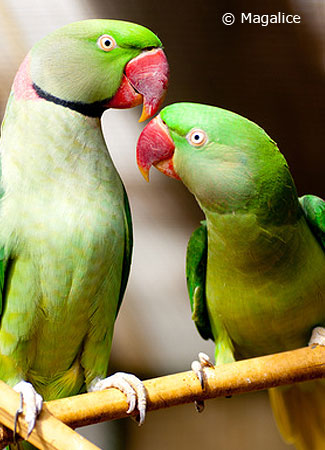
Breeding season varies from location to location. These birds cannot breed in colonies as they become aggressive protecting their nest and offspring. Most fights during the breeding season can easily lead to serious injury or death. Breeding the pairs should be done in roomy aviaries and only one pair per cage. Some breeders will add dividers between aviary walls to keep the birds focused on breeding.
It is recommended these ringnecks have deeper nesting boxes or boot shaped nesting boxes as this provides security for the female. If the boxes are wooden, it is suggested they be reinforced with metal plates on the outside to ensure the female will not chew through the bottom. Many breeders simply use metal boxes as they last longer, are durable, and are easier to clean after the breeding season has finished.
Each nesting box should have wood shavings placed on the bottom of the box before it is placed into the breeding cage. When the female Alexandrine begins to work the nest, she might remove most of the shaving. The breeder should simply return a few handfuls back into the box to ensure the eggs will have padding when laid.
Once the breeding season has started, the female will lay between two to four eggs. She will incubate the eggs for 26 days. Before hatching is about to begin, the chicks will make a small hole from inside the eggs for breathing. Hatching usually follows within 24 to 48 hours after this hole is made. Once the chicks hatch, the mother will feed them every few hours. The babies will leave the nest around seven to eight weeks and can be fully weaned around 10 weeks if kept with their mother.
If the eggs are removed and placed into an incubator early in the breeding season, the breeder should be able to get two clutches per year.
BABY ALEXANDRINE PARAKEETS
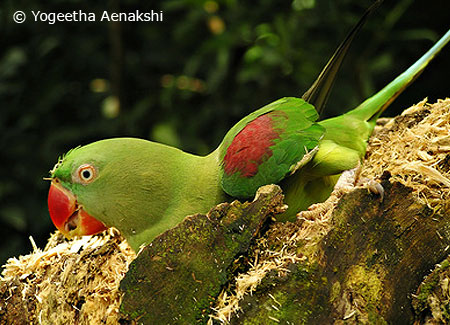
If the baby Alexandrines Parakeets are taken for hand feeding, the oldest baby in the clutch should be about 15 days before the whole clutch is removed. Just before feeding a commercial formula, the breeder should let the crop empty completely from the mother’s feedings.
The babies will grow rapidly and a person should interact with the birds on a daily basis. The birds should be placed on their backs, talked to, and played with to continue a stimulus.
Once the chicks become older and show more interest in solid foods, the breeder should place fresh fruits, vegetables, pellets, and seeds into the weaning cage. It is important the babies not be starved when weaning as this is not the ideal way to encourage the babies to eat on their own. As most Alexandrines start approaching week six or seven, many start to refuse large feedings. This is normal and the chick should be allowed to have its fill then be done. To off shoot this behavior, the breeder should feed the parrots more frequently throughout the day.
When weaning, let the parrot set the pace as it will eventually eat on its own. Handfed Alexandrines tend to take a bit longer to wean than if they were with their parents. Expect weaning to be around 12-14 weeks.
Before the juveniles wings are clipped, the bird should be able to fly well and have good coordination. Some Alexandrine breeders will do a gradual clip to the wings so that it doesn’t shock the bird.
HOUSING A PET ALEXANDRINE PARAKEET
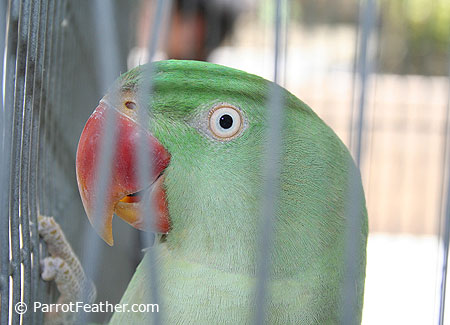
Housing a pet Alexandrine requires a large cage because of their large tails. These birds need thicker cage bars as they can easily dismantle most wire. Their cage should be powder coated and the bar spacing no larger than an inch apart. If the spacing is any larger than an inch, the parrot could get its head stuck or get hurt trying to squeeze out.
A grill should be placed at the bottom of the cage for easy cleaning to ensure the parrot cannot touch its droppings nor have access to rancid foods that fall to the ground of the cage.
A strong perch such as ironbark or rosewood should be used inside the cage to ensure the perch does not become a chewable toy.
Food and water bowels should never be placed under perches as they can quickly become contaminated with droppings and make the parrot ill.
FEEDING AN ALEXANDRINE PARROT
Feeding an Alexandrine parrot is simple because these parrots eat everything a human eats. They should be given a base diet of seeds and pellets accompanied with fresh fruits and vegetables.
Foods to avoid are avocado, alcohol, sugary candies, and chocolate.
Many owners need not make a big production of cutting fruits and vegetables as this ritual can easily be done alongside the preparation of family meals. All food items can be cut early in the week and rationed throughout the week.
These parrots enjoy steamed carrots, broccoli, and cauliflower. Many owners will make skewers with spinach, raw bell peppers, corn, and squash for their Alexandrines. Fruits such as apples, pears, oranges, and kiwis should be sliced for the bird. The owner should be prepared to wipe down the cage as it can get sticky.
Shelled nuts such as almonds, walnuts, and hazelnuts are highly enjoyed by the parrots. Peanuts can also be part of the diet; however, these nuts should be minimized as they contain too much fat. Some owners choose not to give their bird peanuts as there is a chance of developed bacteria that can cause harm.
Spoon feeding the Alexandrine parrot formula as an adult is important as it minimizes any stress if medications are needed from the vet.
If an Alexandrine is given proper vet care, and a healthy diet, it can have a long lifespan of 20 to 30 years.
[ads]
